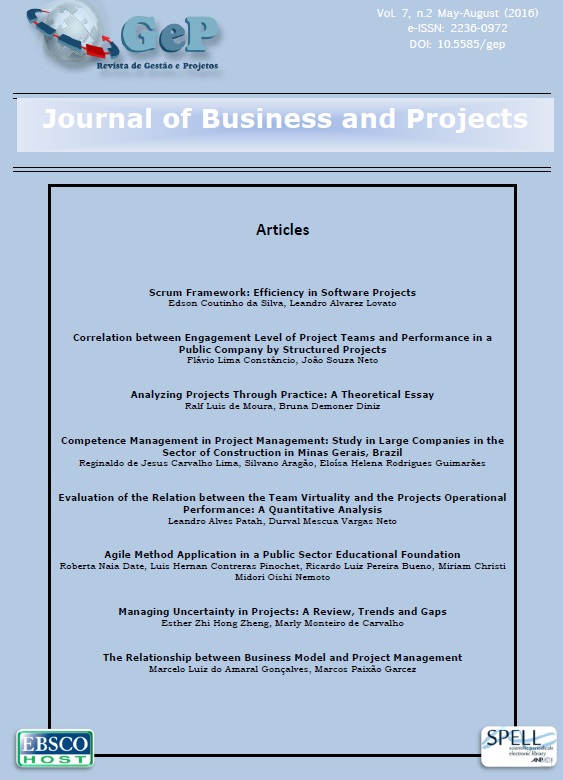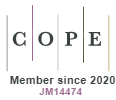Evaluation of the Relation between the Team Virtuality and the Projects Operational Performance: A Quantitative Analysis
DOI:
https://doi.org/10.5585/gep.v7i2.440Keywords:
Project Management, Virtual Teams, Performance Indicators, Operational Performance Project.Abstract
This work has as, its central objective, evaluate the relation between the team virtuality and the projects´ operational performance, measuring this relation in a quantitative way. The methodological procedure adopted in the survey was a quasi-experimental research from the ex post facto type. With this purpose, the statistical techniques of chi-square and the binary logistic regression were used. The database, with its 85 projects, was collected in an international consulting company of risk management business and services, which works with virtual project teams. The results show that there is a dependence relation between the team virtuality and the projects´ performance in terms of time and cost.
References
Abrantes, T. (2014). Servidores do TJ-SP poderão fazer home office. Recuperado em 11, março, 2014, de http://exame.abril.com.br/negocios/noticias/servidores-do-tj-sp-poderao-fazer-home-office.
Ahuja, J. (2010). A Study of Virtuality Impact on Team Performance. IUP Journal of Management Research, 9(5).
Allen, T. J. (1977). Managing the flow of technology: Technology transfer and the dissemination of technological information within the R & D organization (Book). Research supported by the National Science Foundation. Cambridge, Mass., MIT Press, 1977. 329 p.
Anderson, D. Sweeney, D., & Williams, T. (2011). Estatística aplicada à administração e economia. (2. Ed.). São Paulo: Cengage Learning.
Basile, S. (2002). Manual de gestão de pessoas e equipes, 2, 675-688.
Bejarano, V. C., Pilatti, L. A., Scandelari, L., & Oliveira, A. C. (2006). Equipes virtuais – um estudo de caso na indústria têxtil norte-americana. Produção, 16, 161-170.
Besner, C., & Hobbs, B. (2013). Contextualized Project Management Practice: A Cluster Analysis of Practices and Best Practices. Project Management Journal, 44(1), 17-34.
Bryde, D. J. (2003). Modeling Project Management Performance. International Journal of Quality & Reliability Management, 20(2), 229-254.
Chou, J.S., & Yang, J.G. (2012). Project Management Knowledge and Effects on Construction Project Outcomes: An Empirical Study. Project Management Journal, 43(5), 47-67.
Cintra, M. (2013). A crise do trânsito em São Paulo e seus custos. GVExecutivo, 12(2), 58-61.
Crawford, L., Hobbs, J. B., & Turner, J. R. (2004). Project categorization systems and their use in organizations: An empirical study. Project Management Institute. Pennsylvania: Newtown Square.
Duarte, D. L., & Snyder, N. T. (1999). Mastering Virtual Teams. San Francisco, CA: Jossey- Bass.
Duranti, C. M. (2008). Influência de fatores culturais na comunicação em projetos virtuais globais Estudo de caso de uma empresa de Tecnologia da Informação. Dissertação de mestrado, Universidade de São Paulo, São Paulo, SP, Brasil. Disponível: http://www.teses.usp.br/teses/disponiveis/12/12139/tde-07102008-152418/fr.php.
European Commission. (2000). E-Work: Status Report on New Methods to Work in the Information Society. Bruxelas: Office for Official Publications of the European Communities.
Garling, C (2013). Yahoo acaba com trabalho em casa e põe prática em xeque. Recuperado em 04, junho, 2013, de http://economia.estadao.com.br/noticias/negocios-tecnologia,yahoo-acaba-com-trabalho-em-casa-e-poe-pratica-em-xeque,145427,0.htm.
Gibson, C. B., & Cohen, S. G. (2003). Virtual teams that work: Creating conditions for virtual team effectiveness. Wiley. com.
Gomes, A. C. (2003). Gerenciamento de Equipes Virtuais. Revista Capital Científico, 1, 43-57.
Hair, J. F., Anderson, R. E., Tatham, R. L., & Black, W. C. (1998). Multivariate data analysis. New Jersey: Prentice Hall.
Hassegawa, L. N. O. (2002). Papel das Interfaces no Sucesso de Projetos Utilizando Equipes Virtuais. Dissertação de mestrado, Universidade de São Paulo, São Paulo, SP, Brasil. Disponível: http://www.teses.usp.br/teses/disponiveis/12/12139/tde-16082002-171342/pt-br.php.
Howes, N. (2001). Modern project management: successfully integrating project management knowledge areas and processes. Amacom.
Kenny, J. (2003). Effective project management for strategic innovation and change in organizational context. Project Management Journal. Maryland: Project Management Institute Inc., 34(1), p. 43-53.
Kerzner, H. (2009). Gerenciamento de projetos: uma abordagem sistêmica para planejamento, programação e controle. (10. ed.) New Jersey: Jonh Wiley & Sons, Inc.
Kerzner, H. (2011). Project management metrics, KPIs, and dashboards: a guide to measuring and monitoring project performance. New Jersey: Jonh Wiley & Sons, Inc.
Kirkman, B. L., Rosen, B., Tesluk, P. E., & Gibson, C. B. (2004). The impact of team empowerment on virtual team performance: The moderating role of face-to-face interaction. Academy of Management Journal, 47(2), 175-192.
LaBrosse, M. (2008). Managing virtual teams. Employment Relations Today, 35(2), 81-86.
Larson, E., & Gobeli, D. (1989). Significance of project management structure on development success. IEEE Transactions on Engineering Management, 36 (2), 119-125.
Lipnack, J., & Stamps, J. (1997). Virtual teams: Reaching across space, time, and organizations with technology, Wiley, New York.
Martins, G. A., & Teóphilo, C. R. (2009). Metodologia da investigação cientifica para ciências sociais aplicadas. (2 ed.). São Paulo: Atlas.
Mchugh, O., & Hogan, M. (2011). Investigating the rationale for adopting an internationally recognised project management methodology in Ireland: The view of the project manager. International Journal of Project Management, 29(5), 637-646.
Mello, A. A. A. (2011). O uso do teletrabalho nas empresas de call center e contact center multiclientes atuantes no Brasil: Estudo para identificar as forças propulsoras, restritivas e contribuições reconhecidas. Tese de doutorado, Universidade de São Paulo, São Paulo, SP, Brasil. Disponível: http://www.teses.usp.br/teses/disponiveis/12/12139/tde-16082011-154156/pt-br.php.
Milles, J. (1976). The Telecommunications-Transportation Trade-off. John Wiley,88.
Motta, V. T., & Oliveira, P. F., Filho (2009). SPSS: Análise de Dados Biomédicos. Rio de Janeiro: MEDBOOK – Editora Científica.
Patah, L., A. (2010). Avaliação da relação do uso de métodos e treinamentos em gerenciamento de projetos no sucesso dos projetos através de uma perspectiva contingencial: uma análise quantitativa. Tese de doutorado, Universidade de São Paulo, São Paulo, SP, Brasil.
Polete, A. C. (2012). Condicionantes da eficácia do trabalho em equipes de gestão de projetos virtuais. Dissertação de mestrado, Universidade Nove de Julho, São Paulo, SP, Brasil. Disponível: http://www4.uninove.br/tedeSimplificado/tde_busca/arquivo.php?codArquivo=511.
Powell, A., Piccoli, G., & Ives, B. (2004). Virtual teams: a review of current literature and directions for future research. The Data base for Advances in Information Systems, 35, 6-36.
Prasad, K., & Akhilesh, K. B. (2002). Global virtual teams: what impacts their design and performance? Team Performance Management: An International Journal, 8(5/6), 102-112.
Project Management Institute (PMI). (2013). PMBoK: Um Guia do Conhecimento em gerenciamento de projetos. (5 ed.). Pennsylvania: Project Management Institute.
Rabechini, R., Jr., & Carvalho, M. M. (1999). O ambiente de inovação e a gerência de projetos. In: Encontro Nacional De Engenharia De Producão, 19.
Rad, P. F., & Levin, G. (2006). Metrics for project management – Formalized approaches. Management Concepts. Vienna, VA.
Rodrigues, I. (2010). Cultura e desempenho de equipes de projetos globais: um estudo em empresas multinacionais brasileiras. Tese de doutorado, Universidade de São Paulo, São Paulo, SP, Brasil. Disponível: http://www.teses.usp.br/teses/disponiveis/12/12139/tde-13102010-200053/pt-br.php.
Samartinho, J., Resende da Silva, P., & Faria, J. (2012). e-Liderança–Revisão de Literatura, Desafios e Orientações Futuras.
Shenhar, A. J., & Dvir, D. (2010). Reinventando gerenciamento de projetos: a abordagem diamante ao crescimento e inovação bem-sucedidos. São Paulo: M. Books.
Stevenson, W., & McGrath, E. W. (2004). Differences between on-site and off-site teams: manager perceptions. Team Performance Management, 10(5), 127-132.
Terribili, A., Filho. (2010). Indicadores de gerenciamento de projetos - Monitoração contínua. São Paulo: M. Books do Brasil.
Thamhain, H. (2012). The Changing Role of Team Leadershipin Multinational Project Environments. Revista de Gestão e Projetos, 3(2), 04-38.
The Standish Group International. (2013). CHAOS Summary. Recuperado em 25, junho, 2013, de http://www.standishgroup.com.
Toledo, L. A., & Loures, C. A. (2006). Organizações Virtuais. Cadernos EBAPE. BR. 4(2).
Vargas, D. M., Neto, & Patah, L. A. (2013, junho). Indicadores de Desempenho de Projetos que utilizam Equipes Virtuais: O caso de uma Empresa de Consultoria. Congresso Internacional de Gestão de Tecnologia e Sistemas de Informação, São Paulo, SP, Brasil, 10.
Verzuh, E. (2000). MBA Compacto: Gestão de Projetos. Rio de Janeiro: Campus. Spelta, AG, Albertin, AL,436.
Vitoreli, G. A., Lima, C. H. B., Gerolamo, M. C., & Carpinertti, L. C. R. (2010). Relato da utilização de ferramentas e técnicas de gestão de projetos em um projeto de pesquisa acadêmica. Gestão da Produção, Operações e Sistemas, 5(4), p. 111-126.
Downloads
Published
How to Cite
Issue
Section
License
Copyright (c) 2016 Leandro Alves Patah, Durval Mescua Vargas Neto

This work is licensed under a Creative Commons Attribution-NonCommercial-NoDerivatives 4.0 International License.







